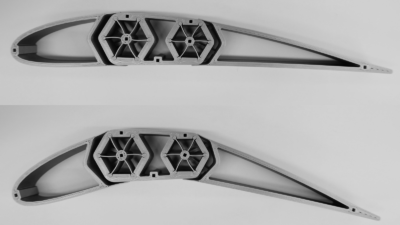Improving efficiency and fuel ignition
By Steven F. Son, Timothy Ombrello, and Campbell Carter|December 2016
The Propellants and Combustion Technical Committee works to advance the knowledge and effective use of propellants and combustion systems for military, civil and commercial aerospace systems.
Traditional solid rocket fuel has two primary problems: The metallic fuel forms large molten droplets during combustion, resulting in up to a 10 percent performance loss that prevents the rocket from realizing its full range and payload capacity. It also emits highly toxic hydrochloric acid that is destructive to the environment and corrodes launch equipment, resulting in substantial maintenance and environmental remediation costs. Andranos Energetics LLC of Ilinois had been conducting research this year and last year in hopes of solving these two problems.
Working with Purdue University, Anranos Energetics is developing Alitec, the trade name for a propellant in which lithium is incorporated into the aluminum to form Al-Li, an alloy. This solid rocket formulation promises to enhance performance and virtually eliminate hyrdochloric acid production.
As with any solid propellant, Alitec is composed of three primary materials — a solid fuel anoxidizer and a binder. It is novel because Al-Li is used as the fuel instead of aluminum. Lithium by itself would be impossible to include because of its reactivity.
Initial research into Al-Li fuel in solid propellants demonstrated significant improvement in theoretical ideal specific impulse , which is the total thrust per unit mass of propellant compared to traditional propellant. The increase in performance is due to better combustion properties and higher efficiencies that are caused by a larger volume of gas being generated during combustion and the large disparity in boiling points of aluminum and lithium. This causes the metallic drops to micro-explode after they leave the surface of the propellant.
Alitec’s performance enhancements would positively impact a wide variety of applications. For example, using Alitec in an air-to-air missile such as the AIM-9 Sidewinder would increase intercept range by as much as 14 percent, providing a significant tactical advantage in air-to-air combat. A surface-to-surface missile such as an MGM-140 ATACMS would travel up to 68 percent farther under a ballistic trajectory. For a space launch system, Alitec will allow for larger payloads to be delivered into orbit. Further work is needed to scale and characterize this propellant.
In research elsewhere, a new tool was developed and applied at the Air Force Research Laboratory in Ohio to establish an a priori ignition probability mapping for high-speed reacting flows. This work builds upon similar efforts by other research groups for gas-turbine-combustor ignition. As in previous work, the overall goal is to supersede time consuming empirical correlations that can be application-specific about where to deposit energy for robust ignition. Multiple targeted experiments of a cavity-based flameholder in Mach-2 flow have been performed at the Air Force Research Laboratory in Ohio to train and validate high-fidelity hybrid Reynolds-Averaged Navier Stokes/Large-Eddy Simulations of a fueled flowfield. Velocity distributions of the fueled, but non-burning cavity, were measured via particle image velocimetry. Nanosecond-gated, laser-induced breakdown spectroscopy was used to map the fuel-air concentrations while also providing an ignition source. The combined experimental and numerical approach has elucidated some of the controlling parameters of ignition. While the parameters of fuel concentration, turbulence intensity and shear play dominant roles at the point of energy deposition, they are also critical as the ignition kernel advects downstream. By using a Lagrangian particle tracking method, the parameter bounds could be invoked on the particle to simulate what the ignition kernel would experience. Overall the new approach has provided the first a priori ignition probability mapping for a supersonic combustor and has established a generic framework for additional refinement and interrogation. ★


































